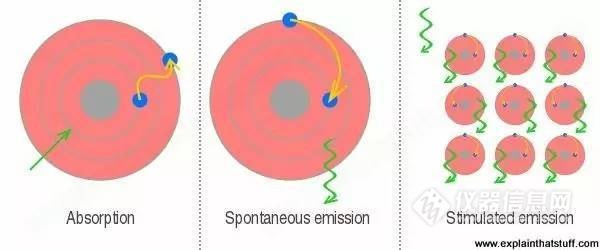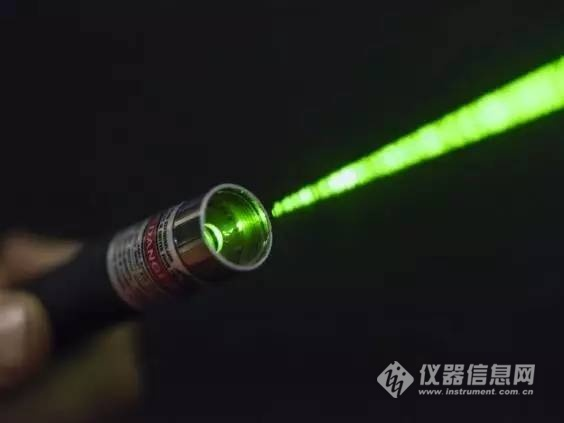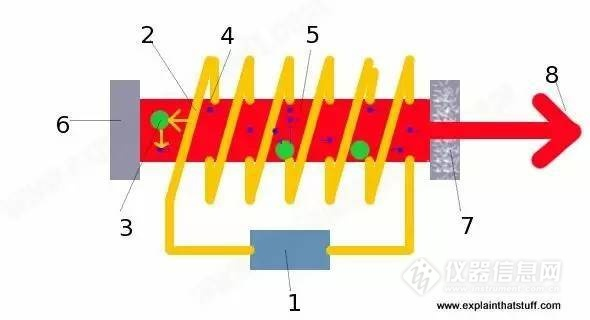Since the United States developed the world's first ruby ​​laser in 1960, China has also successfully developed the first domestic ruby ​​laser in 1961 (born at the Changchun Institute of Optics and Fine Mechanics, Chinese Academy of Sciences). Laser technology is considered to be the 20th century following quantum physics. Another major scientific and technological achievement after the study, radio technology, atomic energy technology, semiconductor technology, and computer technology. Today, CDs and DVD players used in our homes, laser printers in the office and bar code scanners in the mall have lasers. People use lasers to treat nearsighted vision and send emails to browse videos over fiber optic networks. Whether we realize it or not, each of us uses lasers every day, but how many people really understand what lasers are and how do they work? Laser is a kind of light that does not exist in nature and is emitted by excitation. It has the characteristics of good directionality, high brightness, good monochromaticity and good coherence. The mechanism of laser generation can be traced back to the hypothesis that Einstein explained the law of blackbody radiation in 1917, that is, the absorption and emission of light can be through three basic processes: stimulated absorption, stimulated radiation and spontaneous emission. It is well known that the luminescence of any kind of light source is related to the state of motion of the particles inside it. When a particle at a low energy level (atoms, molecules, or ions) absorbs the appropriate frequency and the external energy (light) is excited to transition to the corresponding high energy level (stimulated absorption), it always tries to transition to a lower energy level. Go and release the excess energy in the form of photons. If the light is spontaneously released without the action of external photons (spontaneous radiation), the light that is released at this time is ordinary light (such as electric lights, neon lights, etc.), which is characterized by the frequency, direction and pace of the light. Very inconsistent. However, if the excess energy is released as photons (excited radiation) when the external photon directly acts from the high energy level to the low energy level, the released photons and the external incident photons are in the frequency, phase, propagation direction, etc. The aspect is completely consistent, which means that the external light has been strengthened, which we call optical amplification. Figure: Laser generation mechanism: (left) stimulated absorption, (middle) spontaneous emission, (right) stimulated emission The laser generation needs to meet three conditions: particle number inversion, cavity feedback, and satisfying threshold conditions. By stimulated absorption, the more the number of particles at a higher energy level is at a lower energy level (the number of particles is reversed), it is also necessary to produce parallel reflection surfaces capable of reflecting photons at both ends of the active region to form a resonant cavity and The gain is greater than the loss, that is, the number of newly generated photons at the same time is greater than the number of photons absorbed by the scattering. It is only possible to generate lasers if these three conditions are met. Laser characteristics The laser is known as the magic light because it has four characteristics that ordinary light does not have at all. 1. Good directionality - ordinary light source (sun, incandescent or fluorescent) emits light in all directions, and the direction of laser light can be limited to less than a few milliradians solid angle, which makes the illumination in the illumination direction increase Times. The laser has a diffusion diameter of less than 1 meter per 200 kilometers. If it hits the moon 3.8×105km away from the earth, the beam spreads less than 2 kilometers, while the ordinary searchlight spreads to several tens of meters a few kilometers away. Laser alignment, steering and ranging are features that use directionality. 2. High brightness - Laser is the brightest light source in the world. Only the strong flash of hydrogen bomb explosion can compare with it. The brightness of the sun is about 1.865 × 109 cd / m2, and the output brightness of a high-power laser can be 7 to 14 orders of magnitude higher than the brightness of sunlight. Although the total energy of the laser is not necessarily large, due to the high concentration of energy, it is easy to generate high voltage and high temperature of tens of thousands of degrees Celsius or even several million degrees Celsius at a certain small point. Practical applications such as laser drilling, cutting, welding, and laser surgery exploit this feature. 3. Monochromaticity is good - light is an electromagnetic wave. The color of light depends on its wavelength. The light emitted by a common light source usually contains various wavelengths and is a mixture of light of various colors. The sunlight contains visible light in seven colors of red, dens, yellow, green, cyan, blue, and purple, and invisible light such as infrared light and ultraviolet light. The wavelength of a laser is concentrated only in a very narrow spectral band or frequency range. For example, the wavelength of the holmium laser is 632.8 nm, and the wavelength variation range is less than one ten thousandth of a nanometer. The good monochromaticity of the laser provides an extremely advantageous means for precision instruments to measure and stimulate scientific experiments such as certain chemical reactions. 4. Good coherence - Interference is an attribute of volatility. Based on the characteristics of laser with high directivity and high monochromaticity, it is inevitably light with excellent coherence. This characteristic of laser makes holography a reality. Type of laser In the light source, realizing the energy level inversion of the energy level is a prerequisite for achieving optical amplification, that is, a prerequisite for generating laser light. To achieve the inversion of the number of particles, it is necessary to use the power of external light to make a large number of particles that were originally in the low energy level transition to the high energy level. This process is called "excitation". The laser we usually refer to is a device that stimulates particles in a light source to generate stimulated radiation transitions, achieves population inversion, and then generates light by stimulated radiation. Although lasers are diverse, the mission is to obtain lasers through excitation and stimulated radiation. Therefore, the laser usually consists of an activation medium (ie, a working substance that can generate a population inversion after being excited), an excitation device (ie, an energy source that can inactivate the population of the activation medium, a pump source), and an optical cavity (ie, The beam consists of three plane mirrors in which the beam is repeatedly oscillated and amplified multiple times. Figure: How the laser works Since we can excite many different kinds of atoms in many different ways, we can (theoretically) manufacture many different kinds of lasers. There are many ways to classify lasers, the most famous of which are solids, gases, liquid dyes, semiconductors and fiber lasers. The solid state laser medium is similar to a ruby ​​rod or other solid crystalline material, and the flash tube wound thereon pumps the energy-filled atoms. In order to work effectively, the solid must be doped, a process that replaces some of the atoms with impurity ions, giving them the proper energy level to produce a laser of a certain precise frequency. Solid state lasers produce high power beams, usually very short pulses. In contrast, gas lasers use a noble gas (so-called excimer laser) or carbon dioxide (CO2) as a medium to produce a continuous bright light. CO2 lasers are powerful and efficient, and are commonly used in industrial cutting and welding. Liquid dye lasers use a solution of organic dye molecules as a medium. The main advantage is that it can be used to produce a wider optical band than solid state and gas lasers, and can even be "tuned" to produce different frequencies. Divided by wavelength, covering the wavelength range including far infrared, infrared, visible light, ultraviolet to far ultraviolet, and recently developed X-ray lasers and gamma ray illuminators under development; According to different excitation methods, there are light excitation (light source or ultraviolet light excitation), gas discharge excitation, chemical reaction excitation, nuclear reaction excitation, etc. According to different output modes, there are continuous, single pulse, continuous pulse and ultra short pulse; From the perspective of the size of the power output, the continuous output power is as small as microwatts, up to megawatts. The pulse output can range from microjoules to more than 100,000 joules, with pulse widths ranging from milliseconds to picoseconds to femtoseconds (1000 trillionths). A wide range of lasers meet different application requirements. For example, laser processing and some military lasers require high-power lasers or high-energy lasers (so-called strong lasers). Some hope that the pulse time will be shortened as much as possible to study some express processes. Some also put forward high requirements for improving the monochromaticity of light, improving the mode of output light, improving the light intensity distribution of the spot, and requiring wavelength adjustment. These requirements have prompted laser researchers to continue to explore, so that the depth of exploration and application breadth of the laser has never been developed. Flourishing laser applications The so-called laser technology is a general term for exploring various methods for generating lasers and for exploring the application of these characteristics of lasers for the benefit of mankind. For more than 50 years, laser technology and applications have developed rapidly, and have been combined with many disciplines to form multiple application technology fields, such as optoelectronic technology, laser medical and photonic biology, laser processing technology, laser detection and metrology technology, laser holography technology, Laser spectroscopy, nonlinear optics, ultrafast laser, laser chemistry, quantum optics, laser radar, laser guidance, laser separation isotope, laser controlled nuclear fusion, laser weapons, etc. The emergence of these cross-cutting technologies and new disciplines has greatly promoted the development of traditional and emerging industries. 1. Laser application in the field of information Semiconductor lasers and fiber amplifiers are two key technologies for fiber-optic communications. The laser emitted by the semiconductor laser is not only monochromatic and coherent, but also the frequency of the light wave is 10,000 times higher than the microwave frequency. Therefore, the laser is the carrier for transmitting information, and the optical fiber communication using the optical fiber as the information transmission line not only has good communication quality and resistance. The interference ability is strong, the confidentiality is good, and the communication capacity is tens of thousands times higher than the microwave communication. The use of laser technology for optical storage has revolutionized the storage of information. A CD audio disc has a recording density equivalent to 10 million bits/cm2, and can record 78 minutes of music programs, which are orders of magnitude larger than compact discs. Figure: Laser and lens of a disc in a CD or DVD player. The small circle at the lower right is a semiconductor laser diode, and the larger blue circle is a lens that reads light after the laser reflects from the smooth surface of the optical disk. In addition, laser printers, laser fax machines, laser phototypesetting, laser large-screen color TV, fiber-optic cable TV, and atmospheric laser communication have been widely used. 2. Application of laser in the field of holography As a kind of wave phenomenon, light represents its physical quantity with wavelength (related to color), amplitude (related to the intensity of light) and phase (representing the relationship between the starting point of fluctuation and the reference time). People use the photographic method to record only the wavelength and amplitude, so no matter how realistic it is, it is always different to look at the photos and see the real scene. The laser has high coherence and can acquire all the information of the interference wave space including the phase. Therefore, by using a laser for holography, all the information of the object being photographed is recorded on the negative film, and by the diffraction of light, the stereoscopic image of the ingested object can be reproduced. Hologram has the characteristics of three-dimensional imaging, can be repeatedly recorded, and each small holographic film can reproduce the complete stereoscopic image of the object, which can be widely used in precision interferometry, non-destructive testing, holographic photoelasticity, micro-strain analysis and vibration analysis. Scientific research. Among them, the use of holographic interferometry to study the gas combustion process, the vibration mode of the mechanical parts, the bonding quality of the honeycomb panel structure and the subcutaneous defect inspection of automobile tires have been widely used. Moreover, holograms have been used as an anti-counterfeiting mark for commodities and credit cards. The use of holograms to capture precious works of art not only appreciates them, but also provides a reliable and realistic basis for the restoration of artworks. The holographic TV that is developing will also add a new life experience to people. 3. Laser application in the medical field The application of laser in medicine is divided into two categories: laser diagnosis and laser treatment. The former uses laser as the information carrier, while the latter uses laser as the energy carrier. In laser diagnosis, the laser can penetrate deep into the tissue for diagnosis, directly reflect the tissue condition, and provide a sufficient basis for doctor diagnosis. In laser treatment, laser technology has become an effective means of clinical treatment, and has become a key technology for the development of medical diagnosis. It solves many problems in medicine. For example, laser surgery treats small incisions, has little or no damage to tissues, and has little side effects. At present, laser clinical applications include myopia correction, retinal repair, caries repair, molecular-level minimally invasive surgery, etc. The current excellent application of laser medicine is mainly reflected in the following aspects: photodynamic therapy for cancer; laser treatment for cardiovascular disease; excimer Laser keratoplasty; laser cosmetic surgery; laser fiber endoscopic surgery; laser laparoscopic surgery; laser thoracoscopic surgery; laser arthroscopic surgery; laser lithotripsy; laser surgery; laser application in anastomosis; Oral, maxillofacial surgery and dental applications; weak laser therapy. At present, laser treatment has maintained a sustained and strong development momentum in basic research, new technology development, and new equipment development and production. Figure: Laser application in the field of stomatology 4. Laser processing The high intensity (brightness) focused laser beam of the laser can emit 100 J of light energy in 1 ms, which is enough to melt or vaporize the material in a short time, so that materials with different characteristics can be processed, such as welding. , punching, cutting, heat treatment, lithography, etc. Laser processing has the advantages of high precision, small distortion, no contact, energy saving, etc. Its application field can cover almost the entire machinery manufacturing industry, including mining machinery, petrochemical, electric power, railway, automobile, ship, metallurgy, medical equipment, aviation, Machine tools, power generation, printing, packaging, mold, pharmaceutical and other industries. The wear and corrosion of key components and precision equipment can be repaired and optimized by laser cladding technology, which becomes a magic weapon. 5. Precision measurement The precision measurement utilizes the characteristics of good laser monochromaticity, strong coherence and good directivity. Compared with other range finder, laser ranging has the advantages of long detection distance, high precision, anti-interference, good confidentiality, small size and light weight. The range finder emits a light pulse, and after being reflected by the measured object, the light pulse returns to the receiving system to measure the transmission and reception time interval. The laser has both high brightness and high coherence, which makes the Doppler effect of light applicable in speed measurement. A laser radar is a radar system that emits a laser beam to detect the position and velocity of a target. From the working principle, there is no fundamental difference between Lidar and microwave radar: transmitting a detection signal (laser beam) to the target, and then comparing the received signal reflected from the target (target echo) with the transmitted signal, appropriate After processing, information about the target, such as target distance, azimuth, altitude, speed, attitude, and even shape, can be obtained to detect, track, and identify targets such as aircraft and missiles. It plays an important role in the military field. Role has also become a powerful weapon for environmental monitoring. In addition, the detection of gravitational waves is also the use of laser interferometry to directly detect the gravitational waves in the middle and low frequency bands, to observe the gravitational wave radiation generated by the combination of double black holes and the maximum mass than the celestial bodies, and other cosmic gravitational wave radiation. process. Laser is one of the most important inventions of mankind in the 20th century. The application of laser technology has been extensively applied to all aspects of industry, agriculture, military, medicine and even society. It is playing an increasingly important role in the progress of human society. Change our world in general. Reflective Dog Leash (also called a lead, lead line or tether) is a rope or similar material used to control an animal by attaching it to a collar, harness, or halter. In British English, a leash is generally for a larger (possibly dangerous or aggressive) animal, with lead being more commonly used when walking a dog. Reflective Dog Leash,Elastic Dog Leash,Training Dog Leash,Nylon Training Dog Leash Yangzhou Pet's Products CO.,LTD , https://www.paiqipets.com






Changchun Institute of Optics and Mechanics, Chinese Academy of Sciences: "Previous and Present Life" of Laser Technology